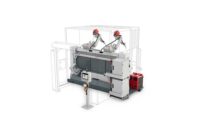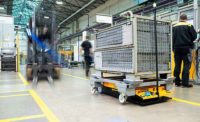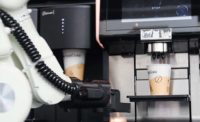Five Things: The Automate Show

The MP1000R autonomous mobile robot can navigate autonomously in highly dynamic environments without additional infrastructure. Photo courtesy Bosch Rexroth

With eBUS Edge, manufacturers can design or upgrade imaging systems for advanced applications, including 3D inspection and IIoT systems, without investing in new hardware. Photo courtesy Pleora Technologies

The Condition Monitoring Tool Kit is an easy-to-implement system that enables engineers to gain insights into the actual condition of their machines and detect problems early. Photo courtesy Balluff Inc.

BSH Home Appliances envisions a bright future for smart glasses, both in assembly plants and in the home. Photo courtesy Tooz Technologies

The Flex-Dial Chassis System is a standardized automation platform that promises to minimize the cost of construction and commissioning. Photo courtesy Weiss North America Inc.





1. Autonomous Mobile Robot
Using RoKIT Locator Software, the MP1000R autonomous mobile robot (AMR) is able to navigate autonomously in highly dynamic environments without additional infrastructure.
Flexible and scalable, the MP1000R can replace manual forklifts and tuggers in manufacturing spaces, leading to improved efficiency and helping protect workers from injury. Forklifts and tuggers are involved in thousands of warehouse accidents each year. The MP1000R can safely and autonomously transport finished goods, raw materials and work in process on pallets or shelves within a factory or warehouse with the same flexibility as human-operated pallet jacks, forklifts or tuggers.
In collaboration with leading AMR provider Geek+, Bosch Rexroth developed the simultaneous localization and mapping (SLAM) technology for the MP1000R. The CE- and ETL-certified robot features hybrid navigation with SLAM and QR codes; 360-degree obstacle detection; anti-collision bumpers; and emergency stop buttons in the front and rear.
The MP1000R can lift a maximum payload of 1,000 kilograms on a standard rack or shelf base. It can also interface with customer-specific equipment using a square or roller top conveyor at customized heights. A large-capacity 39 amp-hour lithium battery provides continuous power for a typical eight-hour work shift via autonomous opportunity charging.
Its compact size and zero turning radius enable it to operate in tight spaces or aisle widths as small as 55 inches. Fully loaded, it can move at a maximum speed of 1.5 meters per second. It can position itself with an accuracy of ±10 millimeters.
The MP1000R has minimal IT requirements and can easily interface with existing systems. It connects to on-site servers using existing wireless infrastructure. Engineers can trigger robot actions via a web browser or handheld device. Application programming interfaces are available to connect the robot software to PLCs, ERP, MES and warehouse management systems.
For more information, click here.
2. Software Simplifies Sensor Design for Advanced Inspection
Pleora Technologies has expanded its machine vision portfolio with software that converts embedded platforms, sensors and cameras into GigE Vision devices.
With eBUS Edge, manufacturers can design or upgrade imaging systems for more advanced applications, including 3D inspection and multisensor Industrial Internet of Things (IIoT) systems, without investing in new hardware. The software converts 3D images and data into GigE Vision and GenICam compliant time-stamped data that is transmitted with associated metadata over low-latency Ethernet cabling.
In IIoT and robotics applications, engineers can use eBUS Edge to create small-form-factor GigE Vision embedded imaging and sensor devices that are easily networked and integrate with machine vision processing systems. In these multisensor applications, embedded processing can make local decisions, transmit processed data to other sensors or standard vision processing systems, and respond to control requests from a host controller over a low latency GigE Vision Ethernet connection.
For more information, click here.
3. Kit Lets Engineers Monitor Machines, Processes
Imagine knowing at an early stage which machine or component in an assembly plant could cause problems in the near future. It is possible. However, many plants do not have the technical prerequisites for condition monitoring, even though this can prevent unplanned downtime and unnecessary costs. Retrofitting equipment has often failed due to the effort and cost involved.
Now, Balluff Inc. has introduced the Condition Monitoring Tool Kit (CMTK), an easy-to-implement system that enables engineers to gain insights into the actual condition of their machines and detect deviations and problems at an early stage. All components are matched with each other. CMTK is a complete system, without hidden costs or subscription fees.
The CMTK consists of three components: software, a base unit and up to four arbitrary IO-Link sensors.
The base unit is the central element of the CMTK. This is where the sensors are connected directly. At the same time, it is the connection point to the networks and systems where this data is used. The base unit does not require a connection to the machine control system. This means that existing structures and processes remain untouched, and there are no undesirable interactions due to the querying and evaluation of the additional data. An internet or cloud connection is not required in daily operation, so there’s no risk of data falling into the hands of third parties or incurring usage fees.
The software makes it possible to automatically visualize and evaluate collected data on site. In the process, a dashboard is automatically created and configured using existing sensor data, saving time and effort when commissioning the system. The web-based software enables the data to be displayed on various end devices, so that the information is quickly and easily available. Limit values and trend analyses can be set up and configured quickly and easily. Automated monitoring of these values is also possible, and notifications can be sent by e-mail. The data obtained can be used, for example, to detect deviations at an early stage, control the timing of repairs, and optimize maintenance intervals. The data can also be saved and archived for later analysis.
The system is compatible with a range of sensors. All IO-Link sensors available on the market can be used with CMTK. Sensors are simple to integrate and operate; they can record several measured variables at one point; and they can communicate the data quickly and easily. Possibilities include vibration and temperature sensors for monitoring motors and drives; pressure and flow sensors for monitoring pumps and compressors; temperature and humidity sensors for monitoring control cabinets; and capacitive sensors or ultrasonic sensors for detecting fill levels.
The tool kit enables plug-and-play commissioning and visualization of machine data. It outputs warning messages when adjustable limit values are exceeded. The self-sufficient system includes data storage, independent of cloud and machine control systems. Remote monitoring from any location is possible, thanks to network integration.
For more information, click here.
4. Two-Finger Universal Gripper
SCHUNK has introduced a new version of its JGP two-finger universal gripper. The JGP-P offers increased gripping force, greater application flexibility, and a variety of query options.
It is ideal for loading and unloading machine tools, assembly, and pick-and-place tasks. A range of features makes this possible. This includes the robust T-slot guidance with longer base jaw guide. Compared with its predecessor, it allows for the use of gripper fingers that are 30 percent longer. The base jaws are fully guided in the housing in any gripping state. This improves performance and covers a wider range of different applications.
The JGP-P also generates up to 50 percent more gripping force than its predecessor—without an increase in size. This is made possible by the increased surface area of the drive piston. This means that the gripper can easily handle heavier loads, so engineers can specify a smaller gripper to save space and cost.
The gripper is compatible with ten sensors with a range of interrogation options, such as monitoring stroke position or workpiece differentiation. Good or bad parts can be sorted quickly and reliably based on dimensional deviations. From size 64, the JGP-P is also available with diameter 8 inductive sensors.
Flexible mounting options on two sides allow the gripper to be mounted universally in three directions. The supply of compressed air is possible via both screw connection and hose-free direct connection. An integrated sealing air connection also improves process stability. This is particularly important if the gripper is used in conjunction with machining, since it inevitably comes into contact with chips and coolant. An integrated sealing air connection prevents penetration into the gripper.
For more information, click here.
5. Preconfigured Indexing Chassis Simplifies Integration
The Flex-Dial Chassis System from Weiss North America Inc. is a standardized automation platform. The cost of construction, installation and commissioning are minimized, thanks to an innovative plug-and-play design. Before delivery, the system goes through a comprehensive functionality and quality inspection, after which, the system can be set up and put into operation on-site quickly and smoothly.
Each system includes a fully programmable NR Series rotary indexing table; an aluminum dial tooling plate; steel base top plates with T-slots for flexible mounting; a powder-coated machine frame; and integrated standard handling modules as required. Each system is also equipped with a modular, expandable control system, including an indexer control with integrated safety PLC; accessory panels to support up to six single, dual or multiaxis drives; application software; and various fieldbus interfaces, such as Ethernet/IP or Profinet.
Three models are available, with tooling plate diameters of 42, 52 and 67 inches.
For more information, click here.
Looking for a reprint of this article?
From high-res PDFs to custom plaques, order your copy today!










